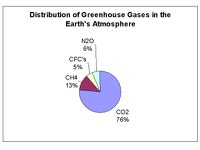
This chart shows the relative contribution of carbon dioxide (CO2) methane (CH4) chlorofluorocarbons (CFCs) and nitrous oxide (N2O) to the total concentration of greenhouse gases in the Earth’s atmosphere. Currently, atmospheric concentrations of CH4, CFCs and N2O are small relative to other greenhouse gases. These compounds, however, have the potential to greatly impact global warming due to their potency and extremely long amount of time that they spend in the atmosphere. (From: IPCC, 1996)
